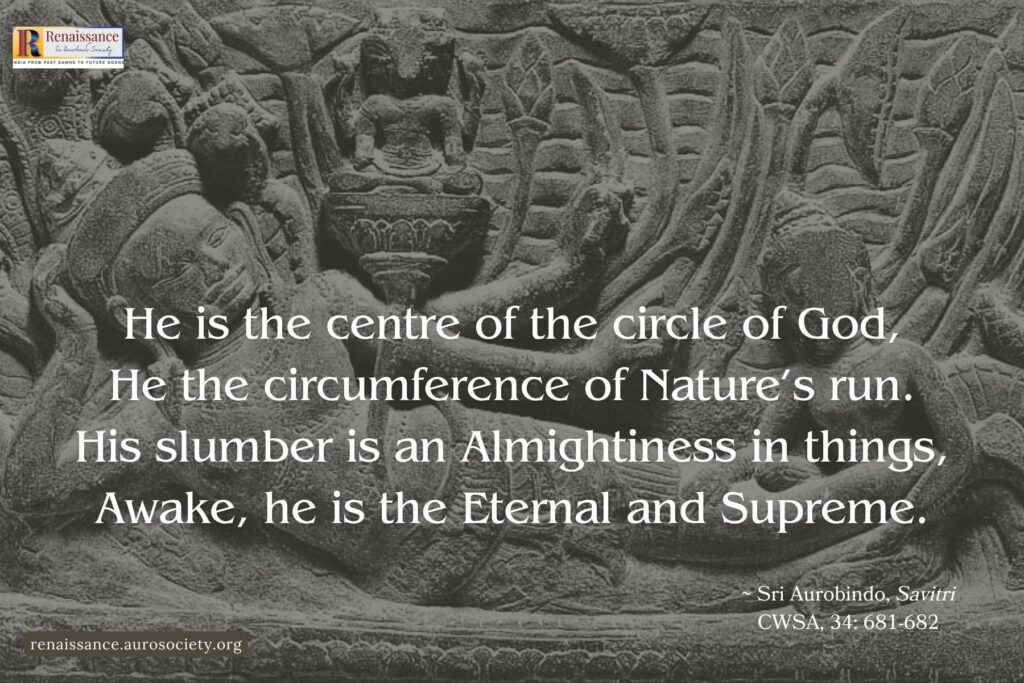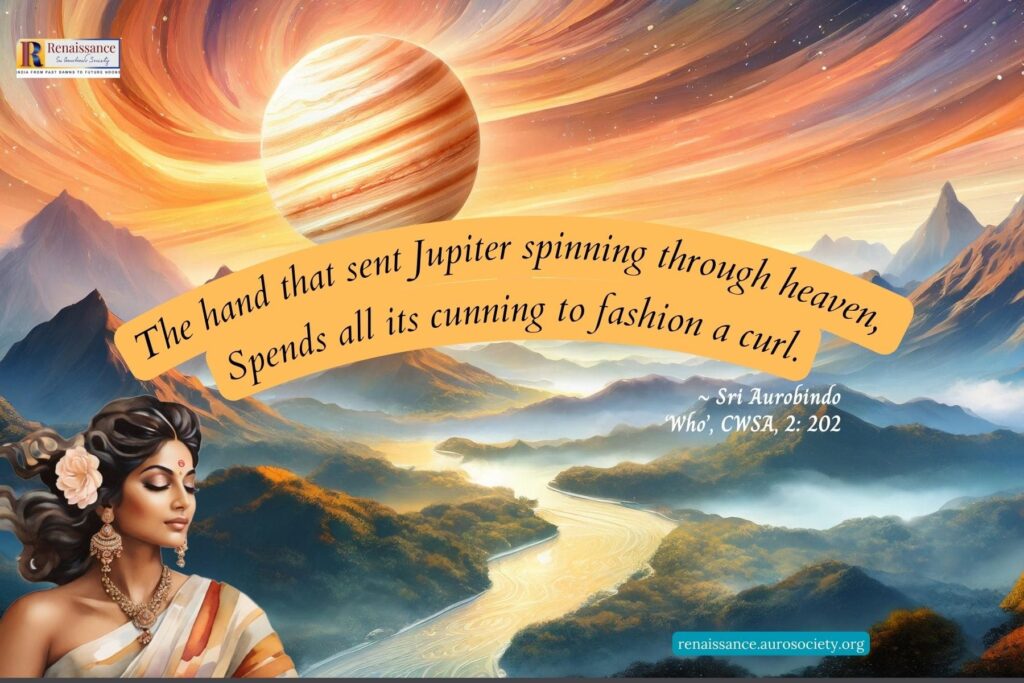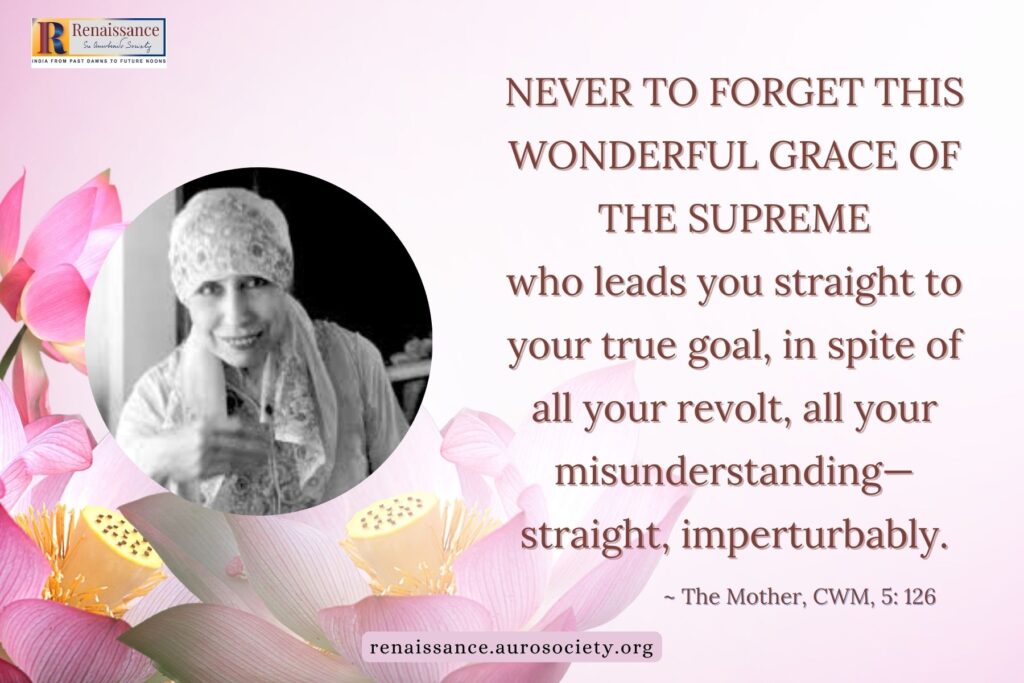The moment one hears of the word ‘Karmayoga,’ one immediately thinks of the Bhagavad Gita and its teaching of nishkāma karma, disinterested action, of focusing only on our action and not on the results, etc. But as Sri Aurobindo explains powerfully in his ‘Essays on the Gita’:
Undoubtedly, the Gita is a Gospel of Works, but of works which culminate in knowledge, that is, in spiritual realisation and quietude, and of works motived by devotion, that is, a conscious surrender of one’s whole self first into the hands and then into the being of the Supreme, and not at all of works as they are understood by the modern mind, not at all an action dictated by egoistic and altruistic, by personal, social, humanitarian motives, principles, ideals.
Yet this is what present-day interpretations seek to make of the Gita. . . the Gita is not a book of practical ethics, but of the spiritual life.
(CWSA, Vol. 19, pp. 30-31)
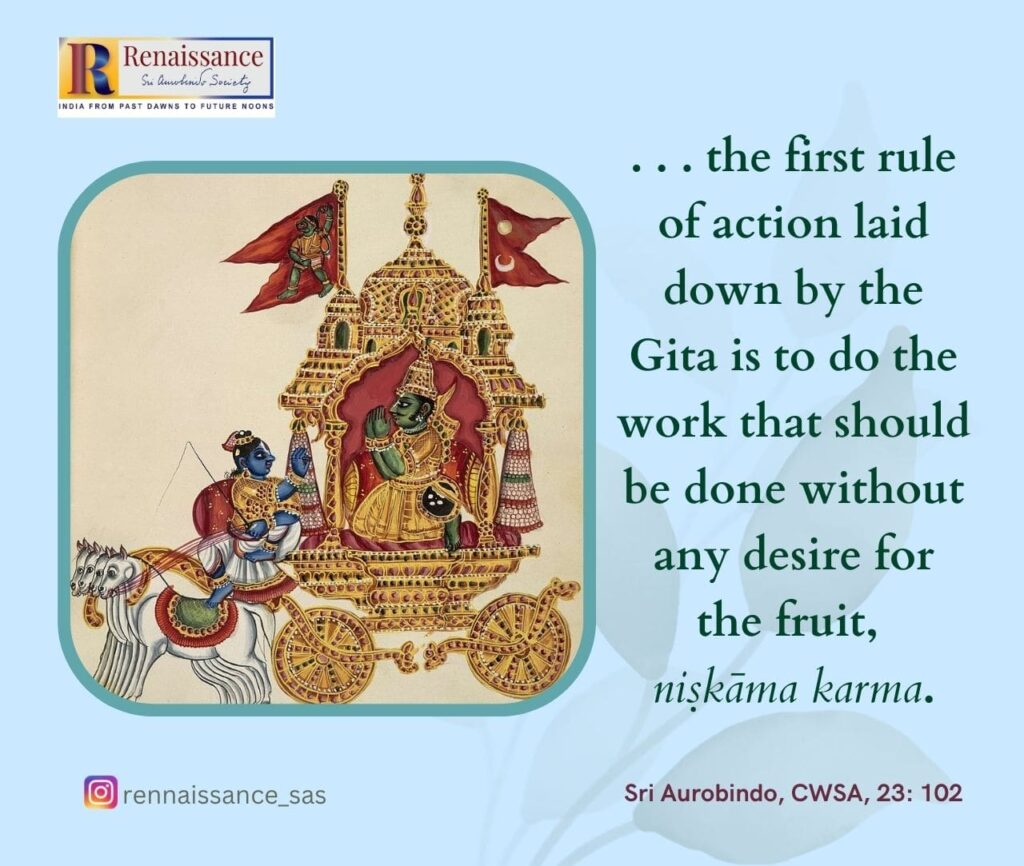
The Gita with its rich and many-sided thought, its synthesis of different aspects of the spiritual life and the fluency of its argumentation style has been prone to one-sided misrepresentations “born of a partisan intellectuality, ” says Sri Aurobindo (CWSA, Vol. 19, p. 29).
He further attributes this misrepresentation to certain tendencies of the modern mentality which he explains thus:
. . . the modern mind has exiled from its practical motive-power the two essential things, God or the Eternal and spirituality or the God-state, which are the master conceptions of the Gita. It lives in humanity only, and the Gita would have us live in God, though for the world in God; in its life, heart and intellect only, and the Gita would have us live in the spirit; in the mutable Being who is “all creatures”, and the Gita would have us live also in the Immutable and the Supreme; in the changing march of Time, and the Gita would have us live in the Eternal.
Or if these higher things are now beginning to be vaguely envisaged, it is only to make them subservient to man and society; but God and spirituality exist in their own right and not as adjuncts. And in practice the lower in us must learn to exist for the higher, in order that the higher also may in us consciously exist for the lower, to draw it nearer to its own altitudes.
(CWSA, Vol. 19, p. 32)
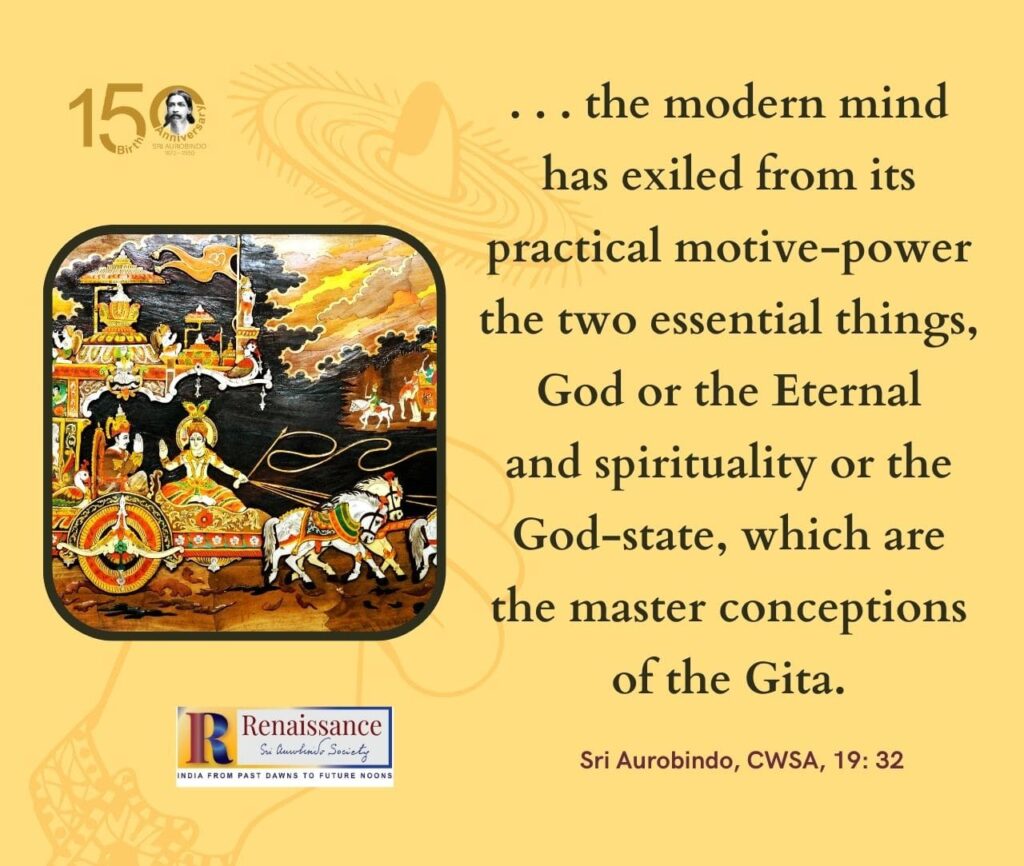
The modern intellectual mind has a tendency to look at the Gita’s teaching as primarily a general spiritual philosophy or ethical doctrine.
But Sri Aurobindo emphasises that the whole teaching of the Gita revolves around Arjuna’s original crisis. And this is a very practical crisis in the application of ethics and spirituality to human life. Therefore, it is essential to first get a clear understanding of the practical crisis that Arjuna faces. It is also essential to understand the significance of the battle of Kurukshetra and its effect on Arjuna’s inner being.
Arjuna, the human disciple of Sri Krishna, the Avatara, is a representative man of his age. In Sri Aurobindo’s words, he receives his initiation on the battlefield of Kurukshetra. He is the type of the “struggling human soul who has not yet received the knowledge, but has grown fit to receive it by action in the world in a close companionship and an increasing nearness to the higher and divine Self in humanity” (CWSA, Vol. 19, p. 20).
Overcome with dejection and sorrow at the most critical moment of his life, Arjuna raises a fundamental question. It is a question regarding human life and action. It is also a question that confronts every human being at some point, in varying intensity.
Arjuna sees his cousins, uncles, grandfathers, gurus and elders all lined up against him in the battlefield. And instantly, several questions regarding his duty as a Kshatriya, his duty to fight the enemy, confront him. He is also conflicted about his right as a prince, the due right to his kingdom. All he sees is an unsurmountable conflict between his right and duty on one side and Dharma on the other. Led by a sense of utter disgust, dejection and revolt, he declares, “I will not fight.”
Sri Aurobindo explains that Arjuna’s crisis is not the questioning of the thinker. Arjuna’s revolt is the sensational, emotional and moral revolt of the man who has, until now, been satisfied with his work and action in life and the standards of conduct which apply to his work.
But suddenly, all those standards are thrown into a “hideous chaos where they are in violent conflict with each other and with themselves and there is no moral standing-ground left, nothing to lay hold of and walk by, no dharma”. This is the worst possible crisis for “the soul of action in the mental being” (CWSA, Vol. 19, p. 25).
Sri Aurobindo cautions that it is a mistake to interpret the Gita from the standpoint of today’s mentality and force it to teach us the disinterested performance of duty as the highest and all-sufficient law.
In human life some sort of a clash arises fairly often, as for instance between domestic duties and the call of the country or the cause, or between the claim of the country and the good of humanity or some larger religious or moral principle. An inner situation may even arise, as with the Buddha, in which all duties have to be abandoned, trampled on, flung aside in order to follow the call of the Divine within.
I cannot think that the Gita would solve such an inner situation by sending Buddha back to his wife and father and the government of the Sakya State, or would direct a Ramakrishna to become a Pundit in a vernacular school and disinterestedly teach little boys their lessons, or bind down a Vivekananda to support his family and for that to follow dispassionately the law or medicine or journalism.
The Gita does not teach the disinterested performance of duties but the following of the divine life, the abandonment of all dharmas, sarvadharmān, to take refuge in the Supreme alone, and the divine activity of a Buddha, a Ramakrishna, a Vivekananda is perfectly in consonance with this teaching.
(CWSA, Vol. 19, pp. 32-33)
As an idea, duty rests upon social conceptions in practice, reminds Sri Aurobindo. Also, duty is a relative term and depends upon our relation to others.
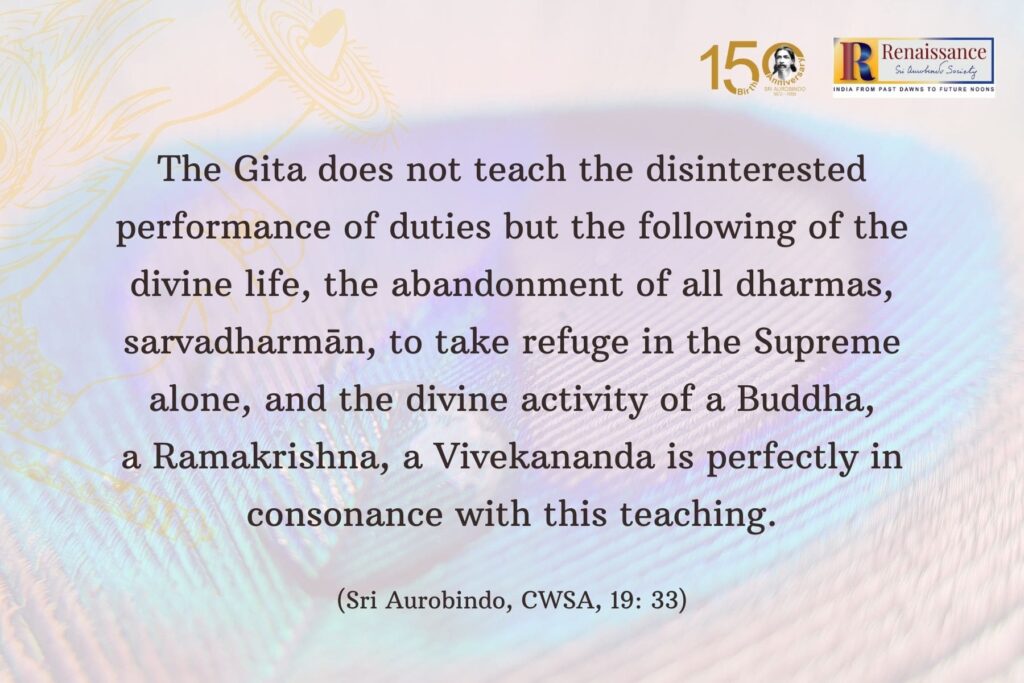
We speak of a mother’s duty to nurture her child or a father’s duty to provide for his family. Or of “a lawyer’s duty to do his best for the client even if he knows him to be guilty and his defence to be a lie; a soldier’s to fight and shoot to order even if he kill his own kin and countrymen; a judge’s to send the guilty to prison and hang the murderer” (CWSA, Vol. 19, p. 34).
So long as one accepts these positions, one’s duty remains clear. It is more or less a practical matter for the individual when asked to discharge his or her duty in a disinterested manner. Even when one’s duty overrides the absolute religious or moral law, as long as an inner acceptance is there, there is no crisis.
But what if the inner view is changed, if the lawyer is awakened to the absolute sinfulness of falsehood, the judge becomes convinced that capital punishment is a crime against humanity, the man called upon to the battlefield feels, like the conscientious objector of today or as a Tolstoy would feel, that in no circumstances is it permissible to take human life any more than to eat human flesh?
It is obvious that here the moral law which is above all relative duties must prevail; and that law depends on no social relation or conception of duty but on the awakened inner perception of man, the moral being.
(CWSA, Vol. 19, pp. 34-35)
This is where Sri Aurobindo helps us understand an important aspect of the Gita’s teaching of Karmayoga.
He describes two different laws or rules of conduct which are valid on two different planes. The first is “the rule principally dependent on external status” and the second and higher one, is “independent of status and entirely dependent on the thought and conscience.”
The Gita does not teach us to subordinate the higher plane to the lower; it does not ask the awakened moral consciousness to slay itself on the altar of duty as a sacrifice and victim to the law of the social status. It calls us higher and not lower; from the conflict of the two planes it bids us ascend to a supreme poise above the mainly practical, above the purely ethical, to the Brahmic consciousness.
(CWSA, Vol. 19, p. 35)
The Gita emphasises that a liberated person, being free from the will of desire and knowing that the Divine is the lord of all his works. He undertakes all types of works but his works are burned up by the fire of knowledge.
His mind remains without any stain from action, calm, silent, unperturbed, clean and pure. Having abandoned all attachment to the fruits of his works, ever satisfied and without any kind of dependence, he continues to engage in action as per his nature.
He is a many-sided universal worker and works for the good of the world, for God in the world. With no personal hopes, he does not seize on things as his personal possessions. He has his heart and self under perfect control. He performs action as an instrument alone, and therefore, does not commit sin (correct meaning of sin is the misapplication of natural faculties, not any externally imposed moralistic notion).
The works of a yogin who is above the dualities, is equal in failure and success, has no envy, has his mind, heart and spirit firmly founded in self-knowledge, and is free from attachment, are dissolved and thus do not bind him.
The liberated man has the knowledge of entire unity of the Brahman. He knows that the Brahman is the manifest doer, the deed and the object of works. Brahman indeed is also the knower, the knowledge and the object of knowledge. Brahman is the universal energy into which all the action is poured. The consecrated energy of the giving is also Brahman. And whatever is offered is only some form of the Brahman, and the giver of the offering is the Brahman himself in man.
The action, the work, the sacrifice is itself the Brahman in movement, in activity. And the goal to be reached by sacrifice is also Brahman. It is with this knowledge the liberated man engages in action as sacrifice.
The Gita replaces the conception of social duty by a divine obligation. The subjection to external law gives place to a certain principle of inner self-determination of action proceeding by the soul’s freedom from the tangled law of works. And this, …the Brahmic consciousness, the soul’s freedom from works and the determination of works in the nature by the Lord within and above us,—is the kernel of the Gita’s teaching with regard to action.
(CWSA, Vol. 19, p. 35)
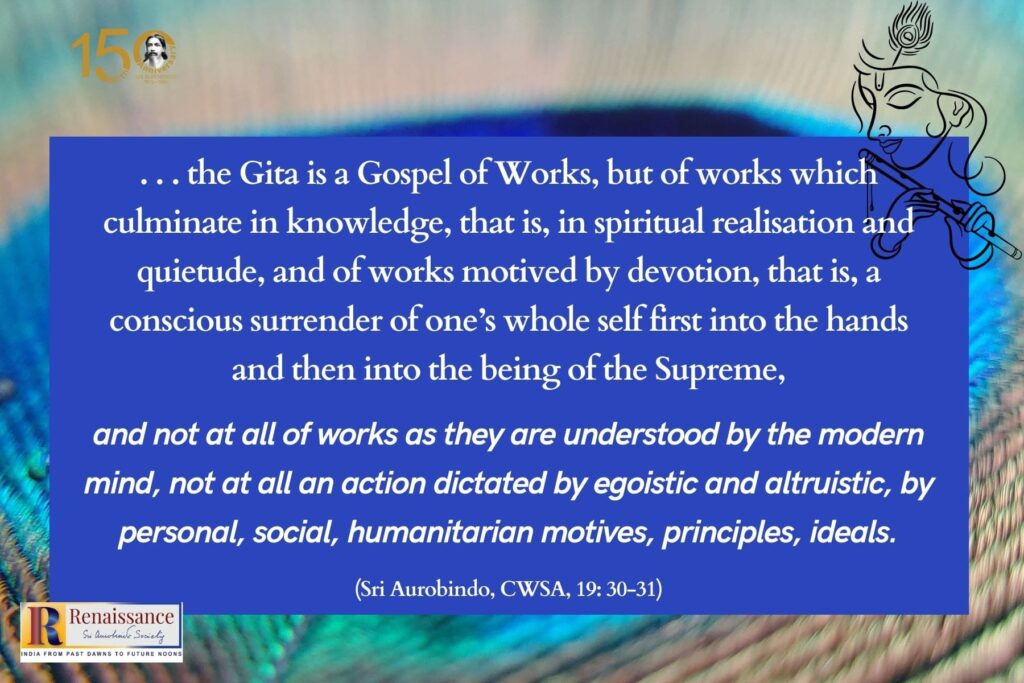
Offerings in this issue
Our theme for the present issue is Work and Yoga. Sri Aurobindo on Work as Sadhana presents some valuable guidance on the value and significance of work in the path of Integral Yoga. The feature titled Working for the Mother or Meditating on Her? further deepens our understanding.
In the feature titled “I make no difference between work and yoga,” the words of the Mother on Work and Surrender are especially relevant for all aspiring to grow inwardly through yoga of works.
Equality in the Yoga of Works: The Way of the Gita presents excerpts from Sri Aurobindo’s The Synthesis of Yoga where he describes the key principles of the Karmayoga as laid down in the Bhagavad Gita.
We also feature selections from Sri Aurobindo’s Letters on Yoga, which speak of the usefulness of work for development of consciousness.
Our features titled Why Work and How to Work and “Spiritually there is nothing big or small” bring practical guidance on developing the right attitude when offering our work as service to the Divine.
Another feature titled Sri Aurobindo on the Mother’s Force in Work and Action highlights some more letters of Sri Aurobindo in which he speaks about how to invoke the Mother’s Force during work.
Integral Yoga is not a yoga for mere individual transformation. It is equally, if not more, concerned with the transformation of collective life. “I do not give positions… I give them work” highlights some highly practical guidance the Mother gave to the sadhaks about the right attitude necessary for sincerely practicing the yoga of works in a collective setting.
We also bring four insightful articles by M. P. Pandit, Shobha Mitra and M. S. Srinivasan and Divyanshi Chugh highlighting some key aspects of work as yoga. Martha Orton reviews a book by Larry Seidlitz which presents insights on Integral Yoga and Work gathered via a qualitative research study. Narendra Murty tells us a Zen story in our Tales and Stories feature.
With this issue, we also begin serialising Prema Nandkumar’s essay on the Mahabharata in the light of Sri Aurobindo. This was first published in the 1985 annual issue of Sri Aurobindo Circle.
As always, we offer this work at the lotus feet of Sri Aurobindo and the Mother.
In gratitude,
Beloo Mehra (for Renaissance Editorial Team)

~ Design: Beloo Mehra

